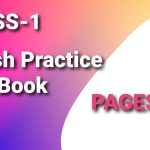Hindi worksheets for Class 1 should be engaging, interactive, and varied to keep young learners interested and motivated.
By including exercises on Varnamala, writing practice, vocabulary, basic grammar, sentence formation, and comprehension, these worksheets can help students build a solid foundation in the Hindi language.
Objectives of Hindi Worksheets for Class 1
The primary objectives of Hindi worksheets for Class 1 are to:
- Familiarize students with the Hindi alphabet (Varnamala).
- Develop reading and writing skills.
- Enhance vocabulary.
- Improve understanding of basic grammar.
- Encourage the ability to form simple sentences.
- Foster comprehension skills through short passages and questions.
Components of a Hindi Worksheet for Class 1
1. Introduction to Varnamala (हिंदी वर्णमाला)
The first step in learning Hindi is to understand and memorize the Hindi alphabet, known as Varnamala. The Varnamala consists of Swaras (vowels) and Vyanjans (consonants). A worksheet should include exercises that help students recognize, write, and pronounce these letters.
Example Worksheet:
Section 1: Swaras (स्वर)
| अ | आ | इ | ई | उ | ऊ | ऋ | ए | ऐ | ओ | औ | अं | अः |
|---|
Activity:
- Trace the letters: अ, आ, इ, ई.
- Match the letter to the corresponding picture.
- अ (अनार)
- आ (आम)
- इ (इमली)
- ई (ईख)
Section 2: Vyanjans (व्यंजन)
| क | ख | ग | घ | ङ | च | छ | ज | झ | ञ | ट | ठ | ड | ढ | ण | त | थ | द | ध | न | प | फ | ब | भ | म | य | र | ल | व | श | ष | स | ह |
Activity:
- Trace the letters: क, ख, ग, घ.
- Match the letter to the corresponding picture.
- क (कबूतर)
- ख (खरगोश)
- ग (गाय)
- घ (घड़ी)
2. Writing Practice
To develop fine motor skills and letter recognition, worksheets should include plenty of writing practice. This includes tracing letters and then writing them independently.
Example Worksheet:
Section 3: Tracing and Writing
Activity:
- Trace the letter: म (मछली)
- Write the letter five times: म
- Complete the word: __मली (च, झ, ग)
3. Vocabulary Building
Building a strong vocabulary is essential for language development. Worksheets should introduce new words and their meanings, along with pictorial representations.
Example Worksheet:
Section 4: Vocabulary
Activity:
- Match the word with the picture:
- आम (Mango)
- सेब (Apple)
- केला (Banana)
- Circle the correct word for the picture:
- (i) गाय (Cow)
- (ii) कुत्ता (Dog)
4. Basic Grammar
Introducing simple grammar concepts such as gender (लिंग), number (वचन), and common verbs is crucial. Worksheets should include exercises that reinforce these concepts.
Example Worksheet:
Section 5: Grammar
Activity:
- Identify the gender (लिंग):
- लड़का (Male)
- लड़की (Female)
- Change the number (वचन):
- बच्चा (Singular) -> बच्चे (Plural)
- Fill in the blanks with the correct verb:
- वह _____ है। (खेल रहा, खेल रही) – (Boy)
- वह _____ है। (खेल रहा, खेल रही) – (Girl)
5. Sentence Formation
Forming simple sentences helps students put their vocabulary and grammar knowledge into practice. Worksheets should provide prompts and spaces for students to create their own sentences.
Example Worksheet:
Section 6: Sentence Formation
Activity:
- Arrange the words to form a sentence:
- आम / मैं / खा / रहा / हूँ। (मैं आम खा रहा हूँ।)
- Complete the sentences:
- मेरा नाम _____ है।
- मैं _____ में रहता हूँ/रहती हूँ।
6. Comprehension
Comprehension exercises are vital for reading skills. Short passages followed by questions can help students practice understanding and interpreting text.
Example Worksheet:
Section 7: Comprehension
Activity:
- Read the passage:
- “राम एक लड़का है। वह स्कूल जाता है। उसे आम खाना पसंद है।”
- Answer the questions:
- राम कौन है?
- राम कहाँ जाता है?
- राम को क्या पसंद है?
Example Worksheets
Worksheet 1: Introduction to Swaras
Worksheet Content:
Section 1: Swaras (स्वर)
| अ | आ | इ | ई | उ | ऊ | ऋ | ए | ऐ | ओ | औ | अं | अः |
|---|
Activity:
- Trace the letters: अ, आ, इ, ई.
- Match the letter to the corresponding picture:
- अ (अनार)
- आ (आम)
- इ (इमली)
- ई (ईख)
Section 2: Writing Practice
Activity:
- Trace and write the letters:
- अ: अ, अ, अ, अ, अ
- आ: आ, आ, आ, आ, आ
- इ: इ, इ, इ, इ, इ
- ई: ई, ई, ई, ई, ई
Worksheet 2: Introduction to Vyanjans
Worksheet Content:
Section 1: Vyanjans (व्यंजन)
| क | ख | ग | घ | ङ | च | छ | ज | झ | ञ | ट | ठ | ड | ढ | ण | त | थ | द | ध | न | प | फ | ब | भ | म | य | र | ल | व | श | ष | स | ह |
Activity:
- Trace the letters: क, ख, ग, घ.
- Match the letter to the corresponding picture:
- क (कबूतर)
- ख (खरगोश)
- ग (गाय)
- घ (घड़ी)
Section 2: Writing Practice
Activity:
- Trace and write the letters:
- क: क, क, क, क, क
- ख: ख, ख, ख, ख, ख
- ग: ग, ग, ग, ग, ग
- घ: घ, घ, घ, घ, घ
Worksheet 3: Vocabulary Building
Worksheet Content:
Section 1: Vocabulary
Activity:
- Match the word with the picture:
- आम (Mango)
- सेब (Apple)
- केला (Banana)
- Circle the correct word for the picture:
- (i) गाय (Cow)
- (ii) कुत्ता (Dog)
Section 2: Writing Practice
Activity:
- Write the words for the pictures:
- (Picture of Mango) आम
- (Picture of Apple) सेब
- (Picture of Banana) केला
Worksheet 4: Basic Grammar
Worksheet Content:
Section 1: Gender (लिंग)
Activity:
- Identify the gender:
- लड़का (Male)
- लड़की (Female)
Section 2: Number (वचन)
Activity:
- Change the number:
- बच्चा (Singular) -> बच्चे (Plural)
- लड़की (Singular) -> लड़कियाँ (Plural)
Section 3: Verbs (क्रिया)
Activity:
- Fill in the blanks with the correct verb:
- वह _____ है। (खेल रहा, खेल रही) – (Boy)
- वह _____ है। (खेल रहा, खेल रही) – (Girl)
Worksheet 5: Sentence Formation
Worksheet Content:
Section 1: Sentence Rearrangement
Activity:
- Arrange the words to form a sentence:
- आम / मैं / खा / रहा / हूँ। (मैं आम खा रहा हूँ।)
- Complete the sentences:
- मेरा नाम _____ है।
- मैं _____ में रहता हूँ/रहती हूँ।
Section 2: Writing Practice
Activity:
- Write sentences about the pictures:
- (Picture of a boy eating an apple) वह सेब खा रहा है।
- (Picture of a girl playing) वह खेल रही है।
Worksheet 6: Comprehension
Worksheet Content:
Section 1: Passage Reading
Activity:
- Read the passage:
- “राम एक लड़का है। वह स्कूल जाता है। उसे आम खाना पसंद है।”
- Answer the questions:
- राम कौन है?
- राम कहाँ जाता है?
- राम को क्या पसंद है?
Section 2: Writing Practice
Activity:
- Write a short passage about your day:
- “आज मैंने स्कूल में खेला। मैंने दोपहर का खाना खाया। शाम को मैंने होमवर्क किया।”
With regular practice, children can develop their reading, writing, and comprehension skills, setting the stage for continued language learning in higher classes.
Latest Posts
- Step-by-step guide to download and apply for jee mains admit card 202
- Comprehensive 2025 government holidays and recruitment details for job seekers
- JEE Mains Admit Card 2025: Your Step-by-Step Guide to Downloading the Hall Ticket
- Everything You Need to Know About 2025 Government Holidays Recruitment
- Comprehensive Guide to rrb d group recruitment 2025 – Eligibility, Vacancies, and Application
- Detailed guide to nps trust recruitment 2025 vacancies, eligibility and apply process
- Comprehensive guide to hpcl recruitment 2025 notification, vacancies, and application process
- ignou bed admission 2025 complete recruitment guide with eligibility and process
- Comprehensive Guide to Indian Army Agniveer Recruitment 2025 Notification and Jobs
- Everything You Must Know About CBSE Board Exams 2025 Changes & New Rules






